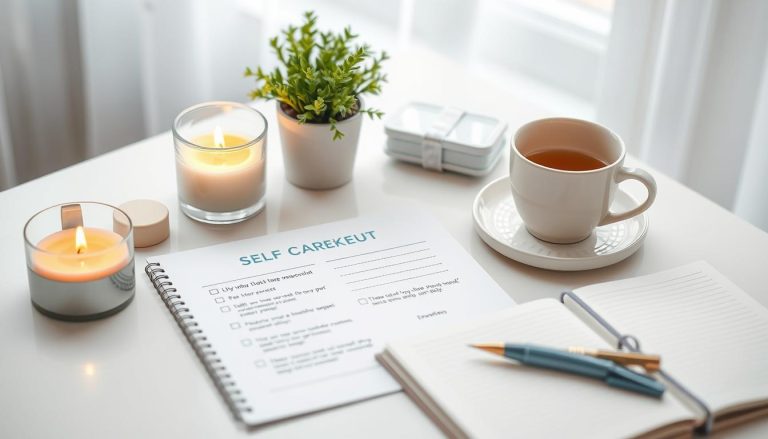Simple DIY Wellness Routines for a Healthier You
This page may contains affiliate links. We may earn a commission for purchases made at no additional cost to you. The content on this website was created with the help of AI.
Every morning gives us a chance to start fresh and choose habits that make us healthier and happier. We all want to feel our best and live a life that reflects our true selves. But how often do we take a moment to think about the power of our daily routines?
DIY wellness practices are special because they fit right into our lives. They help us stay healthy and strong. Starting the day with gentle stretches, drinking water, and meditating are ways to take care of ourselves. These actions help us discover who we truly are.
Studies show that starting the day with a routine can boost our energy. Drinking water first thing in the morning helps us stay hydrated. This simple habit can make a big difference in how we feel.
Our days are filled with moments that need our attention. Taking short breaks to move or relax can improve our focus and health. And as the day ends, a calm evening routine can help us sleep better. People who follow a mindful evening routine sleep 40% better.
We want to live a life that is full and meaningful. Let’s work together to create wellness routines that make us feel our best. Together, we can make a positive change in our lives, one gentle ritual at a time.
Embracing the Power of Morning Stretching
Morning stretches do more than just wake up your body. They are backed by science to boost your day with energy and clear thinking. Stretching not only loosens muscles but also improves mood and sharpens the mind.
The Science Behind Stretching and Improved Circulation
Morning stretches boost blood flow, waking up every cell in your body. This flow of blood warms muscles, bringing oxygen and nutrients. Deep breathing while stretching makes you relax and focus better.

Designing a Morning Stretch Routine That Works for You
Creating a stretching routine that fits you is key. It doesn’t matter if you’re new to stretching or have years of practice. Tailor your stretches to your lifestyle for better health. Find a routine that fits your morning and meets your body’s needs.
| Focus Area | Benefits | Tips for Personalization |
|---|---|---|
| Neck and Shoulders | Improves posture, reduces tension | Include gentle neck rolls and shoulder shrugs tailored to the stiffness level |
| Back (Lower and Upper) | Alleviates back pain, enhances flexibility | Integrate cat-cow stretches, mindful of any lower back discomfort |
| Legs and Hips | Boosts joint mobility, reduces injury risk | Add lunges and forward folds, considering any joint sensitivities |
| Overall Body | Enhances circulation, supports mental health | Consider a short yoga routine that includes breathing techniques |
Spending time each morning stretching is a big health investment. It sets a positive tone for your day, making time for yourself in a busy schedule. Start building a stretching routine that honors your body and improves your life.
Hydration as a Keystone Habit for Health
Drinking enough water is key to staying healthy and feeling good. Water helps our cells work right and helps our body get rid of toxins. By drinking more water, we can feel more alive and full of energy every day.
The Role of Water in Cellular Function and Detoxification
Water does more than just quench our thirst. It’s a must-have for our cells to function well. It helps carry nutrients and oxygen to our cells and helps our body absorb important minerals. It also helps get rid of waste and fight off sickness, keeping our cells healthy.
Strategies for Increasing Daily Water Intake
To drink more water, start small. Drink a glass of water as soon as you wake up. This helps you stay hydrated all day. Carry a water bottle with you to drink more water throughout the day.
Make water taste better by adding lemon, cucumber, or mint. Eating hydrating foods like watermelon and strawberries also helps, especially when it’s hot outside.

| Tip | Description |
|---|---|
| Set a Daily Goal | Set a goal for how much water you want to drink each day. This makes it easier to stay on track. |
| Use Technology | Use apps like Habitify or HabitNow to remind you to drink water. They help you track how much you’ve had. |
| Pair with Meals | Drink a full glass of water before each meal. It helps with digestion and makes you feel fuller. |
By following these tips, we can improve our health. Let’s make small changes to drink more water. Every sip we take brings us closer to a healthier life.
Meditation and Mindfulness for Daily Balance
Adding just a few minutes of daily meditation to our day can greatly improve our well-being. It helps us focus our thoughts, leading to a more balanced life. Apps like Headspace offer guided meditations, helping us manage stress and find peace.

Since 95% of our actions are on autopilot, adding mindfulness practice to our daily life is key. It makes us more aware of our actions and choices. For example, taking a deep breath before meals can make eating more enjoyable and controlled.
Mindfulness isn’t just for meditation; it’s for everyday life too. It helps us stay present and mindful, improving our overall well-being. Even simple activities like moving in sync with our breath can reduce stress and boost our confidence.
| Practice | Benefits |
|---|---|
| Daily Meditation | Reduces anxiety, improves sleep, enhances attention and diabetes control. |
| Mindful Breathing Before Meals | Improves digestion and satisfaction from eating. |
| Mindful Physical Exercises | Reduces stress, aligns body and mind, increases physical capability. |
To truly practice mindfulness, we need to create new habits. This strengthens our brain’s ability to make mindful choices. Regular mindfulness practice and daily meditation can greatly improve our lives.
In conclusion, whether you want to improve your health or find peace, meditation and mindfulness are key. They help us live a more balanced and harmonious life.
Constructing a Nutritious Breakfast for Sustained Energy
Starting your day with a nutritious breakfast is key. It gives you the energy you need. A good breakfast should have proteins, healthy fats, and complex carbs. These nutrients fuel your body for hours and help you make healthy choices all day.
Components of a Balanced Breakfast
A balanced breakfast needs essential nutrients. Aim for 20-30 grams of protein to keep you full and support muscles. Complex carbs give you energy, while fiber helps with digestion. Healthy fats are important for vitamins and long-lasting energy.
Easy, Healthy Breakfast Recipes to Try
Want to make your mornings better? Here are some quick and healthy breakfast ideas:
- Spinach-Avocado Smoothie: It has 18 grams of protein and 8 grams of fiber, great for busy mornings.
- Vegan Freezer Breakfast Burritos: You can make them ahead and keep them for up to three months. They’re perfect for hectic days.
- Flourless Banana Chocolate Chip Mini Muffins: They only take 15 minutes to bake. They’re a tasty, nutritious choice.
These recipes meet different dietary needs and tastes. They help everyone start their day with energy.
| Meal Option | Protein Content | Fiber Content | Preparation Time |
|---|---|---|---|
| Spinach-Avocado Smoothie | 18 grams | 8 grams | 5 minutes |
| Vegan Freezer Breakfast Burritos | Varies | Varies | 30 minutes (prep) |
| Flourless Banana Chocolate Chip Mini Muffins | Less than 5 grams | 2 grams | 15 minutes |
We encourage trying new recipes for balanced breakfasts. Whether it’s a smoothie, mini muffins, or a burrito, aim for nutritious meals every day.

DIY Wellness Routines
Embracing DIY wellness is more than a trend. It’s a lifestyle change that empowers us to take control of our health. By adding daily exercise integration and a consistent sleep schedule, we can live a healthier, more vibrant life.
Let’s explore how to add these elements to our daily lives. This approach boosts physical fitness, mental health, and overall wellbeing.
Integrating Physical Activity into Your Day
Physical activity doesn’t mean hours at the gym. Small, creative movements throughout the day can greatly improve your health. For example, a quick desk exercise or a brisk walk can refresh your mind and body.
These small activities are key. They are essential for a healthy daily routine.
Developing a Consistent Sleep Schedule for Optimal Wellbeing
Sleep is as important as physical activity for DIY wellness. Going to bed and waking up at the same time every day helps regulate our body’s clock. This leads to better sleep and overall health.
Adding calming pre-sleep rituals, like a hot tub session, can be very helpful. The heat from a hot tub improves blood circulation, helping you relax for a good night’s sleep.
| Activity | Benefits | Duration |
|---|---|---|
| Desk Exercises | Boosts circulation, increases productivity | 5 minutes |
| Evening Walks | Enhances overall physical health, reduces stress | 15 minutes |
| Hot Tub Session | Promotes better sleep, relieves stress | 20 minutes |
| Consistent Sleeping Times | Regulates internal clock, improves sleep quality | 7-8 hours |
Adding Daily Exercise Integration, Consistent Sleep Schedule, and DIY Wellness to our routines is beneficial. It helps us manage our lives better and sets a strong foundation for long-term wellbeing. Let’s make these changes together and create positive change in our health and lives.
Beating the Midday Slump with Movement and Nutrition
We’ve all felt that tired feeling after lunch. But, did you know that eating right and moving a bit can help? Let’s look at how to beat the afternoon slump with science-backed tips.
Start with a nutritious lunch. Choose meals with protein, healthy fats, and fiber. They keep you energized longer than high-carb foods. A good lunch might be grilled chicken salad with nuts and a vinaigrette, plus a bit of whole-grain bread.
Also, take short daily movement breaks. A 2011 study found that a quick workout in the middle of the day boosts alertness. Just a 10-minute walk or desk stretch can help.
- Try green tea for a natural energy boost. It has caffeine and antioxidants without the jitters. A 2017 study showed it improves mood and focus.
- Chewing gum can also wake you up. It increases heart rate and blood flow to the brain, making you more alert.
- Follow the 20/20/20 rule to avoid eye strain. Look at something 20 feet away for 20 seconds every 20 minutes if you’re on screens all day.
Using these tips keeps your energy up and supports your health. By sharing this advice, we help ourselves and others. Remember, fighting midday fatigue is about caring for our bodies all day, not just pushing through.
Utilizing Breaks for Increased Productivity and Wellness
We often underestimate the power of well-timed breaks during our workday. Effective breaks can significantly enhance both productivity and overall wellbeing. Structured break activities, whether physical or mental, can rejuvenate our workday and contribute meaningfully to our health and job satisfaction.
Physical Activities for Effective Work Breaks
Integrating physical break activities into your routine isn’t just about stretching your limbs, but also about boosting your brainpower. Regular physical activities during breaks, such as light stretching or a brisk walk, can alleviate the physical and mental fatigue that accumulates over hours of sedentary work. This not only reduces health risks associated with prolonged sitting but also enhances creativity and problem-solving skills.
- Take a 5-minute walk every hour to clear your mind and stretch your legs.
- Engage in desk-side yoga or stretching to keep the blood flowing.
- Try quick exercises like jumping jacks or stair climbing to invigorate your body.
Mental Rejuvenation Techniques During Downtime
While physical activity is crucial, mental rejuvenation during breaks can significantly enhance your focus and energy levels upon returning to your tasks. Techniques such as mindfulness exercises or brief meditative sessions help center your thoughts and allow you to tackle the rest of your day with renewed vigor and clarity.
- Spend 5-15 minutes on simple meditation or deep-breathing exercises.
- Engage in short journaling sessions to reflect and recalibrate your mind.
- Step outside to connect with nature, even if it’s just a nearby park or your office garden.
Here’s a closer look at the benefits of incorporating productive work breaks into your daily routine:
| Activity | Duration | Benefits |
|---|---|---|
| Physical activity (e.g., walking, stretching) | 5 minutes every hour | Improves physical health, enhances mental clarity |
| Meditation/Mindfulness | 10-15 minutes | Reduces stress, boosts concentration |
| Nature engagement | 5-15 minutes | Increases creativity, reduces feelings of fatigue |
Embracing these practices not only fosters a healthier work environment but also promotes a culture of wellness. This can lead to sustained productivity enhancements and increased employee satisfaction. As we integrate these productive work breaks and physical break activities, we not only enhance our wellbeing but also contribute positively to our workplace’s overall health and morale.
Creating an Evening Routine to Wind Down and Restore
We know how important a good evening routine is for sleep and well-being. Adding wind-down activities and restorative practices to our night can help us sleep better. It also prepares us for a great day ahead. Let’s find out what works best for each of us.
| Activity | Percentage | Benefits |
|---|---|---|
| Turn off electronics | 30% | Reduces blue light exposure, aiding in quicker sleep onset. |
| Reading | 29% | Significantly lowers stress within minutes, calming the mind. |
| Bath or Shower | 39% | Enhances sleep quality by relaxing tense muscles and soothing nerves. |
| Consistent bedtime | 34% | Regularizes the body clock, leading to improved sleep patterns. |
Building a good evening routine is about what we do and when we do it. Turning off screens and doing quiet activities like reading or taking a bath helps our mental health. Studies show these habits improve sleep and keep our hearts and brains healthy.
Experts say there are many ways to find what works for you. It could be journaling, yoga, or enjoying soft music and dim lights. The most important thing is to do it regularly and make it your own.
Embracing calm at night through restorative practices is crucial. We hope you’ll make these suggestions fit your life. This way, every night can lead to a brighter, more energetic morning.
Adding Mindful Gratitude to End Your Day on a Positive Note
Ending each day with gratitude is more than a good deed. It’s a way to boost our mental and physical health. By focusing on what we’re thankful for, we shift our mindset to positivity. This greatly improves our overall well-being.
Gratitude Practices with Proven Mental Health Benefits
Studies show that gratitude is good for our minds. It can reduce stress, improve sleep, and make us happier. These practices make us stronger, helping us deal with life’s ups and downs better.
For beginners, start small. Acknowledge your day’s wins or thank those who support you. These simple steps can lead to a more grateful life.
Keeping a Gratitude Journal for Long-term Wellness
Gratitude journals are a powerful tool for lasting appreciation. They help us stay present and build positive memories. Journaling reminds us of the good in our lives, making us happier and healthier.
Here are some key benefits of gratitude journaling:
| Benefit | Impact |
|---|---|
| Stress Reduction | Reduces stress by 28% |
| Sleep Quality | Improves with regular gratitude reflection |
| Emotional and Neurological Happiness | Boosts happiness levels significantly |
| Physical Health | Enhances immune function and lowers blood pressure |
| Resiliency | Strengthens self-worth and accelerates recovery from setbacks |
| Generosity and Compassion | Increases tendencies to be more helpful and generous |
Writing down what we’re thankful for or reflecting on the day’s positives is key. Gratitude practices are a strong path to mental and physical health. They not only improve our lives but also make the world a kinder place.
Achieving a Restorative Night’s Sleep
We know how important restorative sleep is for our health. Studies show that getting at least seven hours of sleep each night boosts our brain, mood, and body. It’s key to have good sleep habits to support our wellness.
Most people don’t need more than eight hours to wake up feeling good. To improve sleep, try not to nap too long during the day. Naps under an hour are okay. Also, avoid alcohol because it can mess with your sleep later.
Regular exercise helps you sleep better. If you can’t sleep, talk to your doctor. They can help figure out why.
Starting a bedtime routine can help your mind get ready for sleep. Make your bedroom cool, dark, and quiet. Use blackout curtains and soft scents to relax.
Dr. David Rosen says to make small changes to sleep better. Don’t get too hard on yourself if it takes time. Start with one or two changes that can really help.






